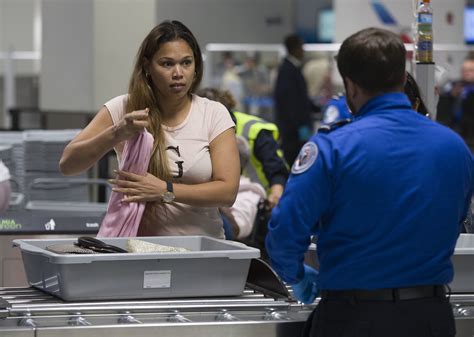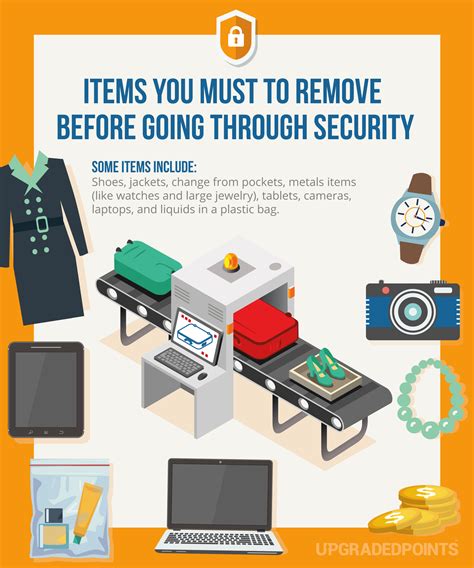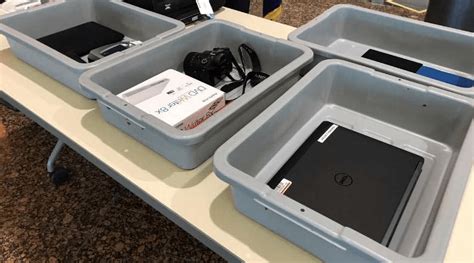
Your smartphone, the device containing your personal information and connection to the world, is reportedly the top item stolen at airport security checkpoints, prompting security experts to advise travelers to keep it out of the ubiquitous TSA bins.
Keep Your Phone Close: Why Experts Warn Against Putting it in TSA Bins
Travelers navigating airport security often face a dilemma: where to place their personal belongings while undergoing screening. The standard procedure involves emptying pockets, removing laptops, and placing these items into the gray bins that glide along the conveyor belt. However, security experts are now strongly advising against placing smartphones in these bins, citing theft as a significant concern. This warning highlights a vulnerability in the security process and underscores the need for travelers to be vigilant about their valuables.
According to a recent report, smartphones are the most frequently stolen items at airport security checkpoints. This revelation has prompted a wave of advice from security professionals urging travelers to adopt alternative strategies for securing their devices. The risk of theft is compounded by the high volume of people passing through security, the often-hurried atmosphere, and the temporary disengagement of travelers as they focus on complying with security protocols.
“It’s the perfect opportunity for thieves,” explains a security analyst, “Passengers are distracted, and their phones are easily accessible in those bins.”
The ease with which smartphones can be pilfered from TSA bins raises serious questions about the security measures in place to protect travelers’ belongings. While the Transportation Security Administration (TSA) focuses on preventing threats to aviation security, the protection of personal property falls somewhat outside their primary purview. This gap creates an opportunity for opportunistic individuals to exploit the situation.
The Vulnerability of the TSA Bin System
The design and operation of the TSA bin system contribute to its vulnerability. The bins are designed for efficiency, allowing for a rapid flow of items through the X-ray machine. However, this efficiency comes at the cost of security. The bins are open and accessible, and there is often little to no direct supervision of the items placed within them. This lack of oversight makes it easy for thieves to discreetly remove a smartphone or other small valuable without being immediately detected.
Moreover, the process of retrieving belongings after screening can be chaotic. Multiple passengers are often reaching for their items simultaneously, creating confusion and further obscuring any potential theft. In this environment, it can be difficult to identify the perpetrator or even to realize that a theft has occurred until after leaving the security area.
Alternative Strategies for Securing Your Smartphone
Given the risk of theft associated with placing smartphones in TSA bins, security experts recommend several alternative strategies:
-
Keep Your Phone on Your Person: The most straightforward solution is to keep your phone on your person whenever possible. This can be achieved by placing the phone in a secure pocket or carrying it in a small bag that remains with you throughout the screening process. However, it is essential to ensure that the phone does not trigger the metal detector, which may necessitate removing it for separate screening.
-
Invest in a Secure Pouch or Wallet: A secure pouch or wallet designed to block RFID signals can provide an added layer of protection against electronic theft, as well as physical theft. These pouches can be carried on your person or placed in a bag that remains with you.
-
Request a Hand Inspection: If you are uncomfortable placing your phone in a bin or carrying it through the metal detector, you can request a hand inspection from a TSA officer. This option allows you to maintain control of your device throughout the screening process, albeit at the cost of some additional time.
-
Observe and Remain Vigilant: Pay close attention to your belongings and the people around you while going through security. Being aware of your surroundings can help you identify potential threats and deter thieves.
-
Use a Clear Bag: Placing your phone (and other valuables) in a clear plastic bag within your carry-on can make it more difficult for thieves to quickly and discreetly grab it. The clear bag allows TSA agents (and you) to easily see the contents, reducing the need to rummage through your belongings and potentially leaving your phone unattended.
The TSA’s Perspective
The TSA acknowledges the risk of theft at security checkpoints but emphasizes its primary mission of preventing terrorism and ensuring aviation security. While the agency encourages travelers to be vigilant about their belongings, it does not assume direct responsibility for lost or stolen items.
“TSA’s focus is on security. We advise passengers to keep their valuables close and be aware of their surroundings,” states a TSA spokesperson.
However, the TSA also provides guidance on reporting lost or stolen items. Travelers who believe their property has been stolen at a security checkpoint are encouraged to report the incident to TSA personnel and local law enforcement. The TSA may also conduct its own investigation, but the primary responsibility for investigating theft typically falls to the local police.
Traveler Experiences and Anecdotes
The risk of theft at airport security is not merely a theoretical concern. Numerous travelers have reported incidents of stolen smartphones, wallets, and other valuables at TSA checkpoints. These experiences highlight the vulnerability of the system and the need for greater vigilance.
One traveler recounted a harrowing experience of having her smartphone stolen while going through security at a major airport. “I placed my phone in the bin along with my other belongings, and when I went to retrieve it, it was gone,” she explained. “I reported the incident to the TSA, but they were unable to recover my phone.”
Another traveler shared a similar story of having his wallet stolen from a bin while going through security. “I was so focused on getting through the screening process that I didn’t realize my wallet was missing until I was already at my gate,” he said. “By then, it was too late to do anything about it.”
These anecdotes underscore the real-world consequences of the security vulnerabilities at airport checkpoints and the importance of taking proactive measures to protect your belongings.
The Broader Context: Airport Security and Theft
The issue of theft at airport security checkpoints is part of a broader context of crime and security in airports. Airports are complex environments with a high volume of people, making them attractive targets for criminals. In addition to theft, other common airport crimes include baggage theft, fraud, and even assault.
Airport authorities and law enforcement agencies work to combat these crimes through a variety of measures, including increased surveillance, security patrols, and public awareness campaigns. However, the sheer size and complexity of airports make it difficult to eliminate crime entirely.
The Role of Technology in Enhancing Security
Technology plays an increasingly important role in enhancing airport security and combating crime. Advanced surveillance systems, biometric identification technology, and data analytics are being used to detect and prevent threats. These technologies can also help to identify and apprehend criminals who operate in airports.
For example, facial recognition technology can be used to identify known criminals or individuals on watch lists. Data analytics can be used to identify patterns of suspicious behavior and alert security personnel to potential threats. These technologies offer the potential to significantly improve airport security and reduce the risk of theft and other crimes.
The Future of Airport Security
The future of airport security is likely to involve a greater integration of technology, enhanced training for security personnel, and increased collaboration between government agencies and private sector partners. The goal is to create a more secure and efficient airport environment that protects travelers from both terrorist threats and criminal activity.
One promising development is the use of advanced imaging technology to screen passengers without requiring them to remove their shoes, belts, or other items. This technology can speed up the screening process and reduce the need for physical contact, which can help to prevent theft.
Another area of focus is the development of more sophisticated baggage screening systems that can detect explosives and other threats more effectively. These systems can help to prevent terrorist attacks and other acts of violence.
Legal Recourse and Insurance Considerations
If your smartphone or other valuables are stolen at an airport security checkpoint, you may have legal recourse depending on the circumstances. You can file a report with the local police department and the TSA, and you may be able to recover your losses through insurance.
Many travel insurance policies cover theft of personal belongings, but the coverage may be subject to certain limitations and exclusions. It is important to review your policy carefully to understand what is covered and what is not.
Homeowners insurance or renters insurance may also provide coverage for theft of personal belongings, even when you are traveling. Again, it is important to review your policy carefully to understand the coverage terms.
In some cases, you may be able to sue the airport or the TSA for negligence if you believe that their actions contributed to the theft of your property. However, these cases can be difficult to win, as you must prove that the airport or the TSA had a duty to protect your property and that they breached that duty.
The Importance of Proactive Measures
Ultimately, the best way to protect your smartphone and other valuables at airport security checkpoints is to take proactive measures to prevent theft. By following the advice of security experts and remaining vigilant about your surroundings, you can reduce your risk of becoming a victim of crime.
This includes keeping your phone on your person, using a secure pouch or wallet, requesting a hand inspection, and observing and remaining vigilant. By taking these steps, you can help to ensure that your travel experience is safe and secure.
Conclusion
The risk of smartphone theft at airport security checkpoints is a real and present danger. While the TSA focuses on aviation security, travelers must take personal responsibility for safeguarding their belongings. By understanding the vulnerabilities of the TSA bin system and adopting alternative strategies for securing their devices, travelers can significantly reduce their risk of theft and protect their valuable personal information. Vigilance, proactive measures, and awareness are key to a safer travel experience. The responsibility ultimately falls on the individual traveler to protect their property in an environment where security priorities lie elsewhere.
Frequently Asked Questions (FAQs)
-
Why are smartphones so frequently stolen at TSA checkpoints?
Smartphones are highly desirable and easily resold, making them attractive targets for thieves. The TSA bin system presents an opportunity for theft because passengers are often distracted and their phones are easily accessible. The high volume of people passing through security and the often-hurried atmosphere also contribute to the risk. As one security analyst noted, “Passengers are distracted, and their phones are easily accessible in those bins,” creating “the perfect opportunity for thieves.”
-
What does the TSA say about the risk of theft at security checkpoints?
The TSA acknowledges the risk of theft but emphasizes its primary mission of preventing terrorism and ensuring aviation security. While the agency encourages travelers to be vigilant about their belongings, it does not assume direct responsibility for lost or stolen items. A TSA spokesperson stated, “TSA’s focus is on security. We advise passengers to keep their valuables close and be aware of their surroundings.” However, the TSA does provide guidance on reporting lost or stolen items.
-
What are some alternative strategies for securing my smartphone at airport security?
Security experts recommend several strategies, including:
- Keeping your phone on your person in a secure pocket.
- Investing in a secure pouch or wallet that blocks RFID signals.
- Requesting a hand inspection from a TSA officer.
- Observing and remaining vigilant about your belongings and surroundings.
- Using a clear bag within your carry-on to make the phone more visible and less easily grabbed.
-
What should I do if my smartphone is stolen at an airport security checkpoint?
If you believe your smartphone has been stolen, you should:
- Immediately report the incident to TSA personnel and local law enforcement.
- File a police report.
- Contact your mobile carrier to suspend service and prevent unauthorized use.
- Check your travel insurance, homeowners insurance, or renters insurance policies for coverage of theft.
- Consider legal recourse, although these cases can be difficult to win.
-
Does travel insurance cover smartphone theft at airport security?
Many travel insurance policies cover theft of personal belongings, but the coverage may be subject to limitations and exclusions. It is important to review your policy carefully to understand what is covered and what is not. Homeowners insurance or renters insurance may also provide coverage. Contact your insurance provider to confirm coverage details and file a claim if necessary.









